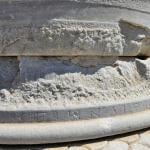A Vatican researcher claims a nearly invisible text on the Shroud of Turin proves the authenticity of the artifact revered as Jesus' burial cloth.
The claim made in a new book by historian Barbara Frale drew immediate skepticism from some scientists, who maintain the shroud is a medieval forgery.
Ms. Frale, a researcher at the Vatican archives, said Friday that she used computers to enhance images of faintly written words in Greek, Latin and Aramaic scattered across the shroud.
She asserts the words include the name "Jesus Nazarene" in Greek, proving the text could not be of medieval origin because no Christian at the time, even a forger, would have labeled Jesus a Nazarene without referring to his divinity.
The shroud bears the figure of a crucified man, complete with blood seeping out of nailed hands and feet, and believers say Christ's image was recorded on the linen fibers at the time of his resurrection.
The fragile artifact, owned by the Vatican, is kept locked in a special protective chamber in Turin's cathedral and is rarely shown.
Skeptics point out that radiocarbon dating conducted in 1988 determined it was made in the 13th or 14th century.
While faint letters scattered around the face on the shroud were seen decades ago, serious researchers dismissed them due to the test's results, Ms. Frale told the Associated Press.
But when she cut out the words from photos of the shroud and showed them to experts, they concurred the writing style was typical of the Middle East in the first century – Jesus' time.
She believes the text was written on a document by a clerk and glued to the shroud over the face so the body could be identified by relatives and buried properly. Metals in the ink used at the time may have allowed the writing to transfer to the linen, Ms. Frale claimed.
She said the text also partially confirms the Gospels' account of Jesus' final moments. A fragment in Greek that can be read as "removed at the ninth hour" may refer to Christ's time of death reported in the holy texts, she said.
I take no position on the authenticity of the Shroud, and agree that we are to believe through the Word only. And yet, I first read about the artifact at a key time in my life, and it reminded me (then in the liberal church of my childhood) that Christianity is not about some vague, cloudy abstractions but about tangible, historical realities. So I am still interested. But defenders of the Shroud need to answer those radio-carbon dates. I would add that if there is writing in Greek on the cloth, that it would be unlikely to have been put there by a European medieval forger, since the Greek language was not known in the West in the 13th and 14th centuries.












